Socio-Economic Drivers of Fish Species Consumption Preferences in Kenya’s Urban Informal Food System
Abstract
1. Introduction
2. Materials and Methods
2.1. Study Area
2.2. Sample Size Determination and Sampling
- p = share of population of interest (;
- q = weighting variable (;
- z = confidence level (;
- E = acceptable error (.
2.3. Data Collection and Analysis
2.4. Econometric Model
3. Results
3.1. Consumer Preferences for Fish Species
3.2. Determinants of Household Preference for Fish Species
4. Socio-Economic Factors Influencing Fish Consumption in Kibera
5. Conclusions
Author Contributions
Funding
Institutional Review Board Statement
Informed Consent Statement
Data Availability Statement
Acknowledgments
Conflicts of Interest
References
- Parnell, S.; Walawege, R. Sub-Saharan African urbanisation and global environmental change. Glob. Environ. Chang. 2011, 21, S12–S20. [Google Scholar] [CrossRef]
- Leon, D.A. Cities, urbanization and health. Int. J. Epidemiol. 2008, 37, 4–8. [Google Scholar] [CrossRef]
- Gallaher, C.M. Livelihoods, Food Security and Environmental Risk: Sack Gardening in the Kibera Slums of Nairobi, Kenya. Ph.D. Thesis, Michigan State University, East Lansing, MI, USA, 2012. [Google Scholar]
- Talukdar, D. Cost of being a slum dweller in Nairobi: Living under dismal conditions but still paying a housing rent premium. World Dev. 2018, 109, 42–56. [Google Scholar] [CrossRef]
- Archambault, C.S.; De Laat, J.; Zulu, E.M. Urban services and child migration to the slums of Nairobi. World Dev. 2012, 40, 1854–1869. [Google Scholar] [CrossRef]
- Olack, B.; Feikin, D.R.; Cosmas, L.O.; Odero, K.O.; Okoth, G.O.; Montgomery, J.M.; Breiman, R.F. Mortality trends observed in population.-based surveillance of an urban slum settlement, Kibera, Kenya, 2007–2010. PLoS ONE 2014, 9, e85913. [Google Scholar] [CrossRef] [PubMed]
- Beyer, L.I.; Chaudhuri, J.; Kagima, B. Kenya’s focus on urban vulnerability and resilience in the midst of urban transitions in Nairobi. Dev. S. Afr. 2016, 33, 3–22. [Google Scholar] [CrossRef]
- Gallaher, C.M.; Kerr, J.M.; Njenga, M.; Karanja, N.K.; WinklerPrins, A.M. Urban agriculture, social capital, and food security in the Kibera slums of Nairobi, Kenya. Agric. Hum. Values 2013, 30, 389–404. [Google Scholar] [CrossRef]
- Crow, B.; Odaba, E. Access to water in a Nairobi slum: Women’s work and institutional learning. Water Int. 2010, 35, 733–747. [Google Scholar] [CrossRef]
- Achungo, B.C. The Social Transformation of the People Living in Kibera Slum in Nairobi County Following the Kenya Slum Upgrading Programme. Master’s Thesis, Institute of Anthropology, Gender and African Studies, University of Nairobi, Nairobi, Kenya, 2014. [Google Scholar]
- KNBS. (Kenya National Bureau of Statistics 2019). Kenya Population and Housing Census: Volume 1: Population by County and Sub-County 2019; Kenya National Bureau of Statistics: Nairobi, Kenya, 2019.
- Desgroppes, A.; Taupin, S. Kibera: The Biggest Slum in Africa? East Afr. Rev. 2011, 44, 23–33. [Google Scholar]
- Gallaher, C.M.; WinklerPrins, A.M.; Njenga, M.; Karanja, N.K. Creating space: Sack gardening as a livelihood strategy in the Kibera slums of Nairobi, Kenya. J. Agric. Food Syst. Community Dev. 2015. [Google Scholar] [CrossRef]
- Kibere, F.N. The Capability of Mobility in Kibera’Slum’, Kenya: An Ethnographic Study of How Young People Use and Appropriate New Media and ICTS. Ph.D. Thesis, Department of Media and Communication, University of Leicester, Leicester, UK, 2016. [Google Scholar]
- Gulyani, S.; Talukdar, D. Informal rental markets: The low-quality, high-price puzzle in Nairobi’s slums. In Urban Land Markets; Springer: Dordrecht, The Netherlands, 2009; pp. 191–223. [Google Scholar]
- Tacon, A.G.; Metian, M. Fish matters: Importance of aquatic foods in human nutrition and global food supply. Rev. Fish. Sci. 2013, 21, 22–38. [Google Scholar] [CrossRef]
- Béné, C.; Barange, M.; Subasinghe, R.; Pinstrup-Andersen, P.; Merino, G.; Hemre, G.I.; Williams, M. Feeding 9 billion by 2050–Putting fish back on the menu. Food Secur. 2015, 7, 261–274. [Google Scholar] [CrossRef]
- Béné, C.; Mehta, L.; McGranahan, G.; Cannon, T.; Gupte, J.; Tanner, T. Resilience as a policy narrative: Potentials and limits in the context of urban planning. Clim. Dev. 2018, 10, 116–133. [Google Scholar] [CrossRef]
- van Berkum, S.; Broeze, S.; Herens, M.; Bertram de Rooij, B.; Soma, K.; Roosendaal, L. Urbanisation, Migration and Food System Transformations: Concepts and Methodologies for a Better Understanding of the Dynamics of Urban Food Systems and Migration Settlements; report no 2020-46; Wageningen Economic Research: Hague, The Netherlands, 2020; 29p. [Google Scholar]
- Obwanga, B.; Lewo, M.R. From Aid to Responsible Trade: Driving Competitive Aquaculture Sector Development in Kenya; Quick Scan of Robustness, Reliability and Resilience of the Aquaculture Sector; Report 2017-092 3R Kenya; Wageningen University & Research: Wageningen, The Netherlands, 2017; 68p. [Google Scholar]
- Yamane, T. Statistics, an Introductory Analysis, 2nd ed.; Harper and Row: New York, NY, USA, 1967; pp. 89–94. [Google Scholar]
- Baskaran, R.; Managi, S.; Bendig, M. A public perspective on the adoption of microgeneration technologies in New Zealand: A multivariate probit approach. Energy Policy 2013, 58, 177–188. [Google Scholar] [CrossRef]
- Wooldridge, J.M. Basic Econometrics, 2nd ed.; Massachusetts Institute of Technology: Cambridge, MA, USA, 2008. [Google Scholar]
- Tarekegn, K.; Haji, J.; Tegegne, B. Determinants of honey producer market outlet choice in Chena District, southern Ethiopia: A multivariate probit regression analysis. Agric. Food Econ. 2017, 5, 1–14. [Google Scholar] [CrossRef]
- Suhaimi, M.; Aisyah, N.; de Mey, Y.; Oude Lansink, A. A Transaction Cost Analysis of Malaysian Dairy Farmers’ Marketing Channel Selection. In Proceedings of the European Association of Agricultural Economists (EAAE) International Congress, Parma, Italy, 28 August–1 September 2017. [Google Scholar]
- Kiritu, H.; Wanyingi, A.; Gathii, L. East Africa Fish Market Assessment; Prepared for: Msingi East Africa; IPSOS Limited: Nairobi, Kenya, 2018. [Google Scholar]
- Chikowi, C.T.; Ochieng, D.O.; Jumbe, C.B. Consumer choices and demand for tilapia in urban Malawi: What are the complementarities and trade-offs? Aquaculture 2020, 530, 735755. [Google Scholar] [CrossRef]
- Kariuki, M.B.J. Analysis of Market Performance: A Case of ‘Omena’ Fish in Selected Outlets in Kenya; No. 634-2016-41486; Egerton University Graduate School: Egerton, Kenya, 2011. [Google Scholar]
- Brunsø, K.; Verbeke, W.; Olsen, S.O.; Jeppesen, L.F. Motives, barriers and quality evaluation in fish consumption situations: A comparison between heavy and light users in Spain and Belgium. Br. Food J. 2009, 111, 699–716. [Google Scholar] [CrossRef]
- Alonso, E.B.; Cockx, L.; Swinnen, J. Culture and food security. Glob. Food Secur. 2018, 17, 113–127. [Google Scholar] [CrossRef]
- Obiero, K.O.; Opiyo, M.A.; Munguti, J.M.; Orina, P.S.; Kyule, D.; Yongo, E.; Karisa, C.H. Consumer preference and marketing of farmed Nile Tilapia (Oreochromis niloticus) and African Catfish (Clarias gariepinus) in Kenya: Case study of Kirinyaga and Vihiga Counties. Int. J. Fish. Sci. Aquat. Stud. 2014, 1, 67–76. [Google Scholar]
- Chege, P.M.; Kimiywe, J.O.; Ndungu, Z.W. Influence of culture on dietary practices of children under five years among Maasai pastoralists in Kajiado, Kenya. Int. J. Behav. Nutr. Phys. Act. 2015, 12, 131. [Google Scholar] [CrossRef] [PubMed]
- Obwanga, B.; Mbauni, C.; Mwangi, C.F.; Soma, K. Food System Value-Chain Adaptability-Can New Opportunities Increase Food Security and Food Safety in Kibera? Linking Aquaculture to Urban Food Systems. Workshop Report-Discussing New Opportunities with the Aquaculture Value-Chains between Nyeri-Kibera; no 2020-066; Wageningen Economic Research: Hague, The Netherlands, 2020; 14p. [Google Scholar]
- Shimokawa, S. When does dietary knowledge matter to obesity and overweight prevention? Food Policy 2013, 38, 35–46. [Google Scholar] [CrossRef]
- Min, S.; Wang, X.; Yu, X. Does dietary knowledge affect household food waste in the developing economy of China? Food Policy 2020, 98, 101896. [Google Scholar] [CrossRef]
- Esilaba, F.A.; Moturi, W.N.; Mokua, M.A. Urban consumers’ fish preferences and the determinants influencing fish selection and consumption: Case study of Nakuru Town, Kenya. Int. J. Fish. Aquat. Stud. 2017, 5, 356–360. [Google Scholar]
- Blekking, J.; Tuholske, C.; Evans, C. Adaptive Governance and Market Heterogeneity: An Institutional Analysis of an Urban Food System in Sub-Saharan Africa. Sustainability 2017, 9, 2191. [Google Scholar] [CrossRef]
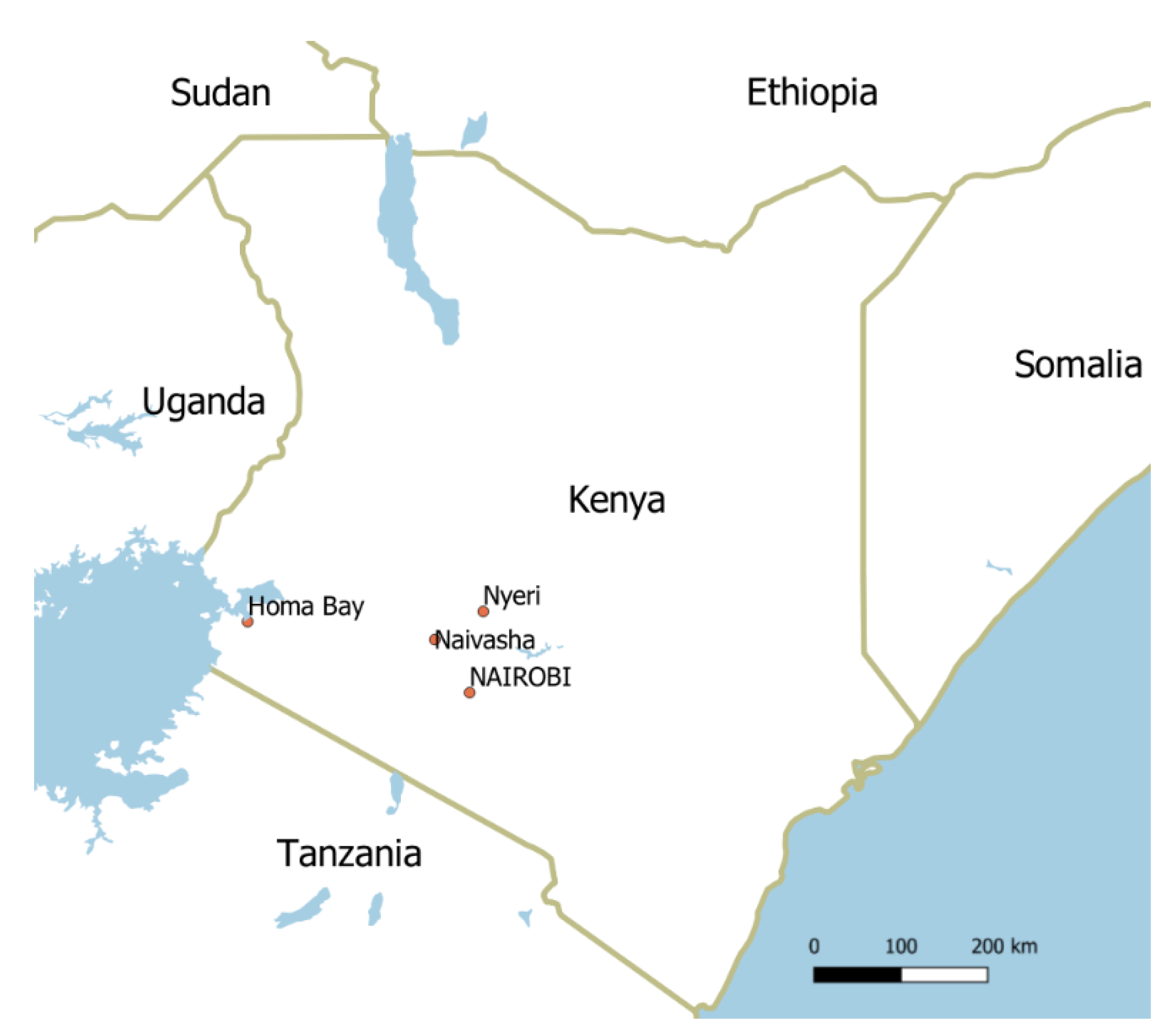
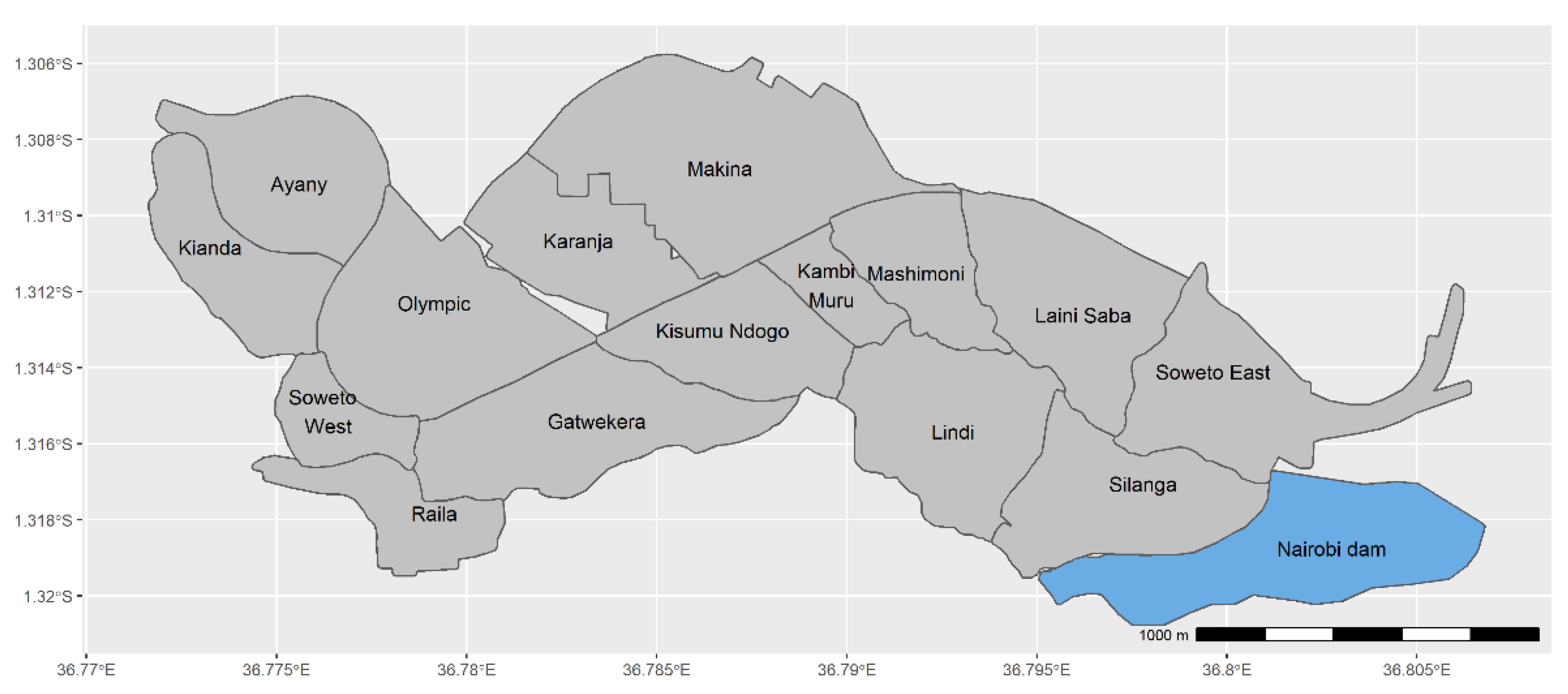

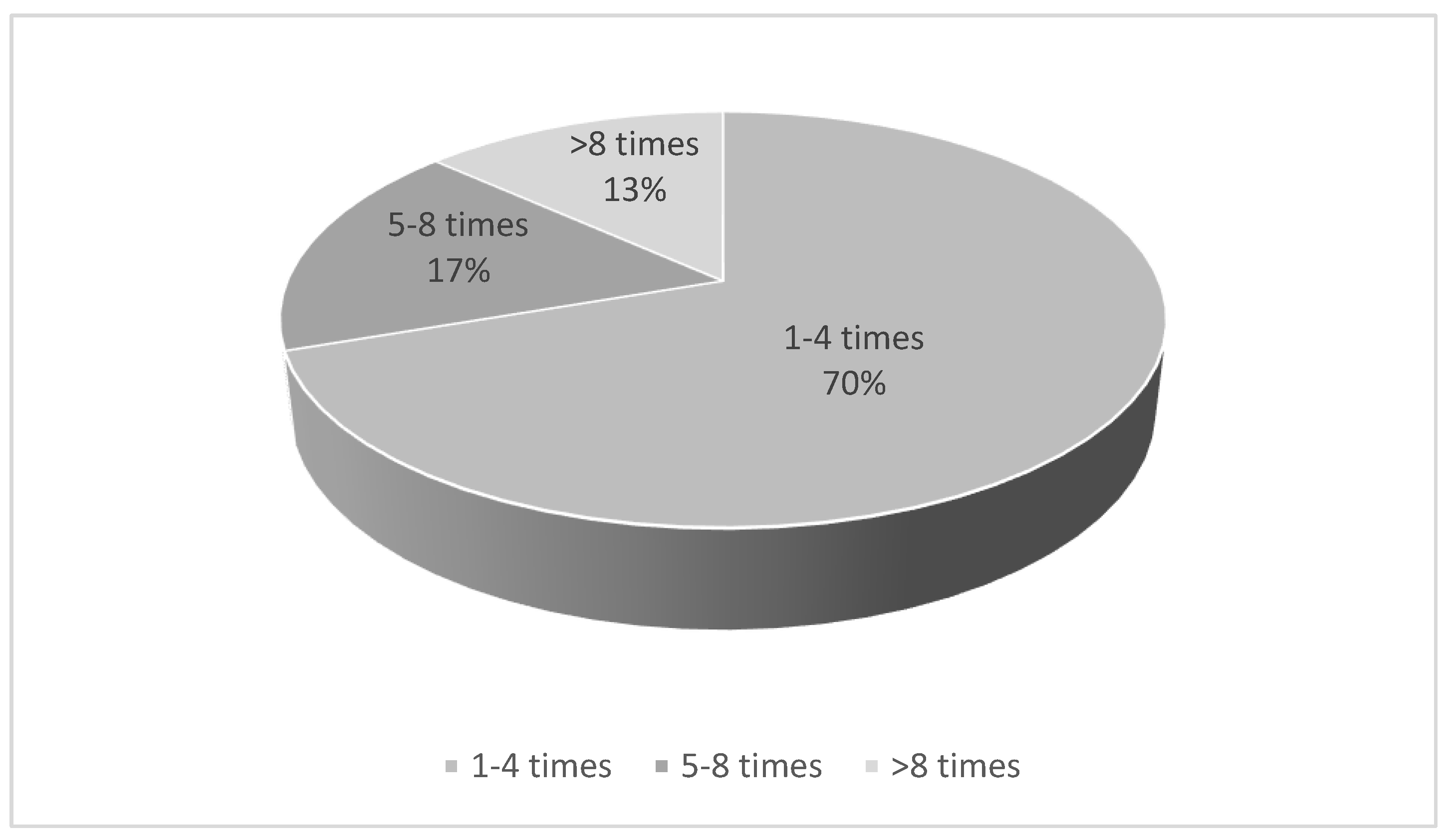
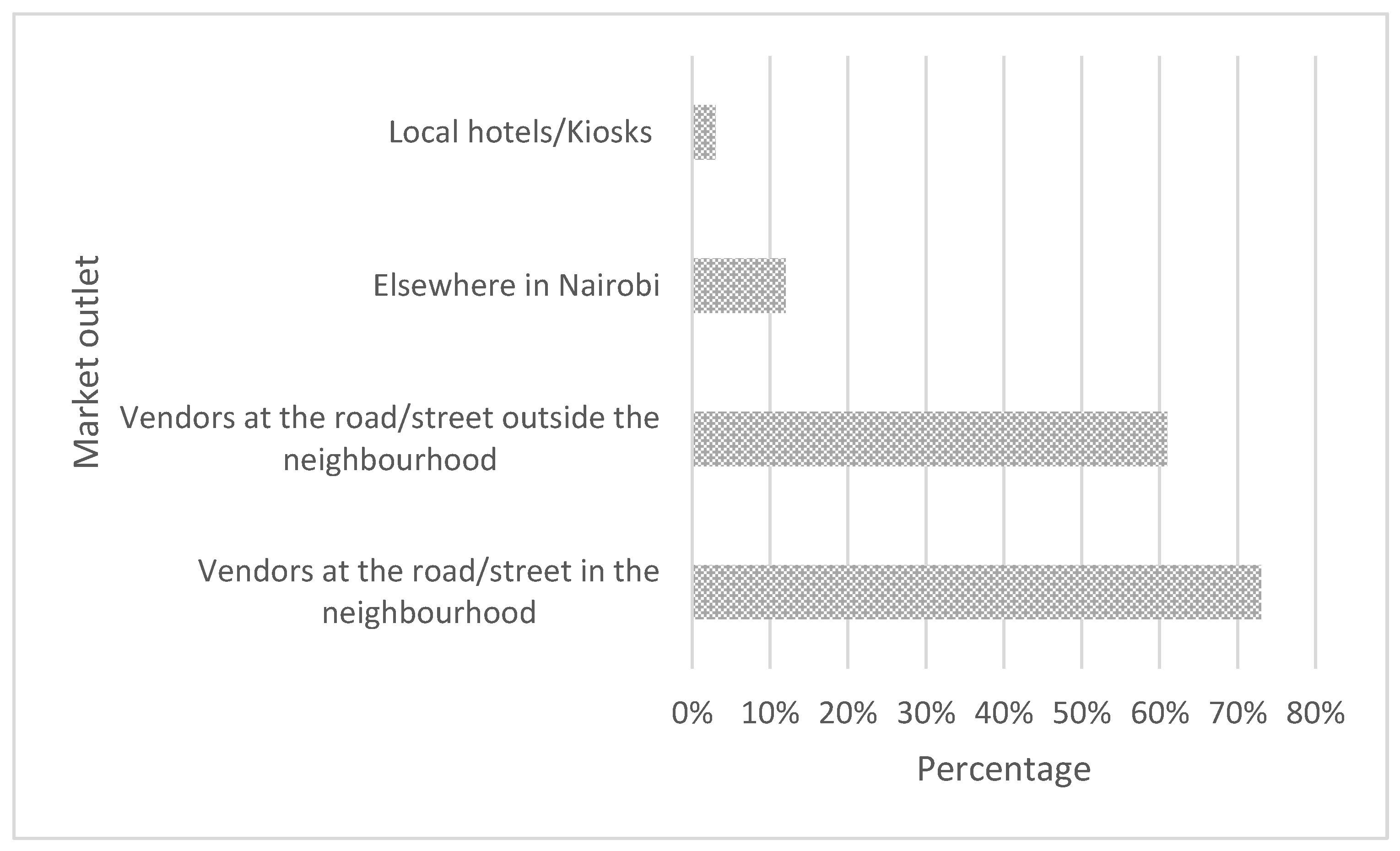
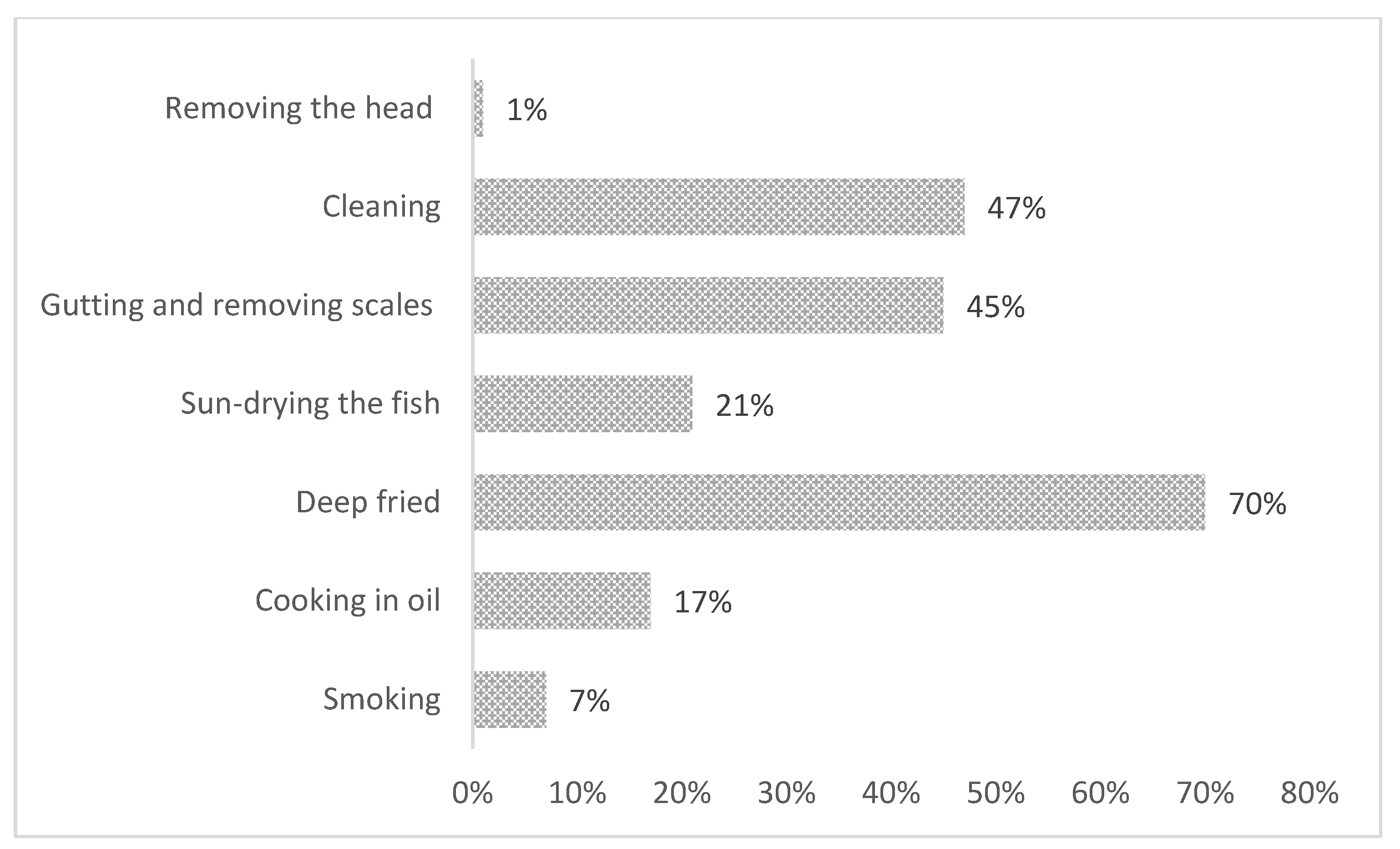
| Tribe | % Composition by Gender | |
|---|---|---|
| Male | Female | |
| Luo | 34.9 | 35.4 |
| Luyia | 26.5 | 32.5 |
| Nubian | 11.6 | 9.1 |
| Kikuyu | 7.9 | 6.4 |
| Kamba | 7.5 | 10.3 |
| Kisii | 6.4 | 2.2 |
| Other tribes | 5.2 | 4.1 |
| Total | 100 | 100 |
| Socio-Economic Characteristics | Mean | Standard Deviation |
|---|---|---|
| Gender of household head (1 = male) | 0.3006 | 0.4591 |
| Education level of household head (0 = none to 5 = college/ university) | 3.2865 | 1.2297 |
| Age of household head (years) | 41.2163 | 12.6721 |
| Number of dependent in a household | 5.0449 | 2.2236 |
| Total monthly household income (in KES (Kenya shillings)) | 13,219.2100 | 10,356.5800 |
| Institutional characteristics | ||
| Neighbourhood effect (% of neighbours from the same tribe) | 46.3118 | 26.8734 |
| Number of fish outlet with 100 m radius | 5.7416 | 4.7886 |
| Migration to Kibera (1 = lived in Kibera since birth) | 0.1713 | 0.3773 |
| Tribal origin (1 = western Kenya, 0 = others) | 0.7753 | 0.4180 |
| Culture influence of food choices (%) | 43.6798 | 30.2607 |
| Religion influence on food choices (%) | 9.1320 | 19.8869 |
| Decision makers on fish (female household head) | 0.7388 | 0.4399 |
| Decision makers on fish (male household head) | 0.2079 | 0.4064 |
| Decision makers on fish (other household members) | 0.0534 | 0.2251 |
| Dietary knowledge index (composite score of between 1 and 45) | 30.0618 | 3.4619 |
| Price sensitivity (Likert 1 = not important to 5 = very important) | 4.4635 | 0.9619 |
| Fish Species | Mean Price EUR (KES) * | Standard Deviation |
|---|---|---|
| Nile tilapia | 3.77 (374.11) | 106.29 |
| African catfish | 3.11 (308.33) | 78.54 |
| Lake Victoria sardine | 1.58 (157.36) | 41.73 |
| Common carp | 2.76 (274.29) | 80.59) |
| Nile perch | 3.42 (339.02) | 131.91 |
| Other fish | 2.51 (249.09) | 89.49 |
| Nile Tilapia | Lake Victoria Sardine | Nile Perch | |
|---|---|---|---|
| Lake Victoria sardine | −0.2435 *** (0.0985) | ||
| Nile perch | −0.3674 *** (0.0950) | −0.1626 (0.09778) * | |
| Other fish species | 0.2453 * (0.01260) | 0.0843 (0.1378) | 0.1290 (0.1171) |
| Likelihood ratio test 39.0199 Prob x2 > p = (0.0000) | |||
| Number of observations 356 | |||
| Log likelihood −658.8552 | |||
| Wald x2 (60) = 109.99, p-value = (0.0001) | |||
| Nile Tilapia | Lake Victoria Sardine | Nile Perch | Other Fish Species | |||||
|---|---|---|---|---|---|---|---|---|
| Coef. | Std. Err. | Coef. | Std. Err. | Coef. | Std. Err. | Coef. | Std. Err. | |
| Socio-economic characteristics | ||||||||
| Gender of household head (1 = male) | −0.2603 | 0.1785 | 0.1498 | 0.1910 | 0.1698 | 0.1878 | −0.0524 | 0.2531 |
| Education level of household head | 0.0676 | 0.0702 | 0.0087 | 0.0741 | 0.0426 | 0.0723 | 0.0005 | 0.1065 |
| Age of household head | 0.0018 | 0.0073 | −0.0109 | 0.0078 | −0.0085 | 0.0078 | −0.0144 | 0.0106 |
| Number of dependent in a household | −0.0364 | 0.0367 | 0.1047 *** | 0.0397 | 0.0446 | 0.0376 | −0.0268 | 0.0510 |
| Total household income | 0.1986 * | 0.1069 | −0.1763 | 0.1124 | 0.2281 ** | 0.1135 | 0.0902 | 0.1507 |
| Institutional characteristics | ||||||||
| Neighbourhood effect | 0.0024 | 0.0029 | 0.0040 | 0.0030 | −0.0050 * | 0.0029 | 0.0018 | 0.0040 |
| Number of fish outlet with 100 m radius | −0.0034 | 0.0164 | 0.0472 ** | 0.0206 | 0.0076 | 0.0162 | 0.0282 | 0.0209 |
| Migration to Kibera (1 = lived in Kibera since birth) | 0.5428 | 0.2249 | −0.4602 | 0.2061 | 0.0456 | 0.2103 | −0.0599 | 0.2838 |
| Tribal origin (1 = western Kenya, 0 = others) | 0.2922 ** | 0.1897 | 0.3388 ** | 0.1933 | 0.0083 | 0.2017 | 0.2369 | 0.2803 |
| Culture influence of food choices | 0.0008 | 0.0027 | 0.0059 ** | 0.0028 | 0.0001 | 0.0028 | −0.0056 | 0.0041 |
| Religion influence on food choices | 0.0070 | 0.0042 | 0.0045 | 0.0041 | −0.0058 | 0.0043 | −0.0168 *** | 0.0045 |
| Decision makers on fish (Female = base category) | ||||||||
| Male decision makers | 0.1770 | 0.1981 | 0.1887 | 0.2064 | −0.1502 | 0.1987 | 0.1583 | 0.2500 |
| Other household members decision makers | 0.4792 | 0.3390 | −0.1774 | 0.3301 | −0.3965 | 0.3805 | 0.7113 * | 0.3893 |
| Dietary knowledge index | −0.0038 | 0.0214 | 0.0074 | 0.0220 | −0.0394 * | 0.0219 | 0.0376 | 0.0334 |
| Price sensitivity | 0.1386 * | 0.0757 | −0.1409 * | 0.0852 | 0.0078 | 0.0764 | −0.0294 | 0.1019 |
| Constant | −2.3817 | 1.2877 | 1.5954 | 1.3210 | −1.4792 | 1.3175 | −2.9448 | 1.9043 |
Publisher’s Note: MDPI stays neutral with regard to jurisdictional claims in published maps and institutional affiliations. |
© 2021 by the authors. Licensee MDPI, Basel, Switzerland. This article is an open access article distributed under the terms and conditions of the Creative Commons Attribution (CC BY) license (https://creativecommons.org/licenses/by/4.0/).
Share and Cite
Ayuya, O.I.; Soma, K.; Obwanga, B. Socio-Economic Drivers of Fish Species Consumption Preferences in Kenya’s Urban Informal Food System. Sustainability 2021, 13, 5278. https://doi.org/10.3390/su13095278
Ayuya OI, Soma K, Obwanga B. Socio-Economic Drivers of Fish Species Consumption Preferences in Kenya’s Urban Informal Food System. Sustainability. 2021; 13(9):5278. https://doi.org/10.3390/su13095278
Chicago/Turabian StyleAyuya, Oscar Ingasia, Katrine Soma, and Benson Obwanga. 2021. "Socio-Economic Drivers of Fish Species Consumption Preferences in Kenya’s Urban Informal Food System" Sustainability 13, no. 9: 5278. https://doi.org/10.3390/su13095278
APA StyleAyuya, O. I., Soma, K., & Obwanga, B. (2021). Socio-Economic Drivers of Fish Species Consumption Preferences in Kenya’s Urban Informal Food System. Sustainability, 13(9), 5278. https://doi.org/10.3390/su13095278





